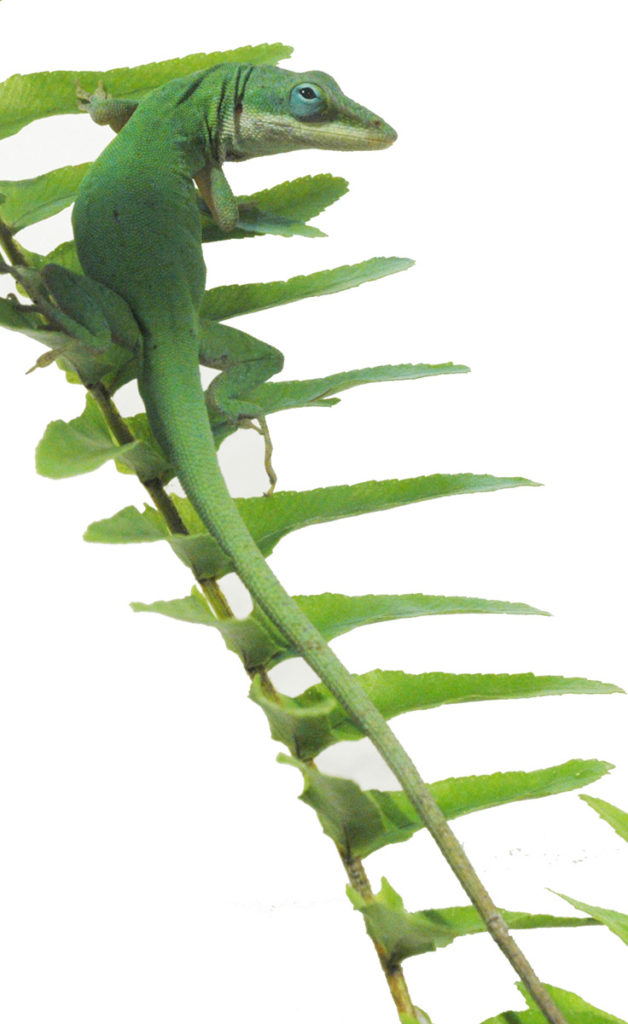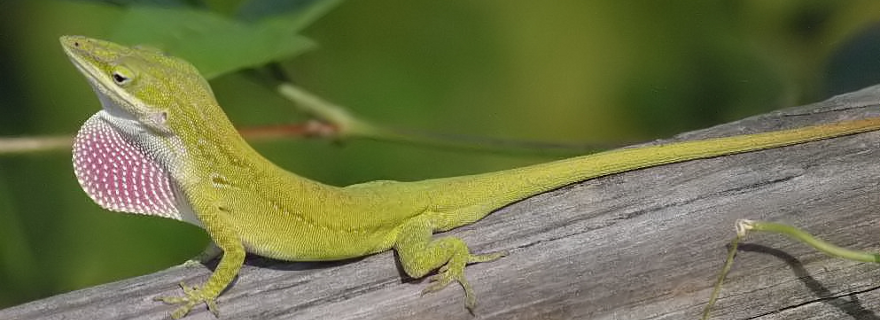It all started when Steve Isham damaged his ankle playing tennis. On crutches, with extra time on his hands, he began paying more attention to the antics of lizards in his Orlando backyard.
“Anoles: Those Florida Yard Lizards” is the result of his curiosity, starting with informal discussions among long-time Florida residents who remember seeing lots more green than brown lizards and concluding with a series of interviews with anole experts across the country.
Rather than a straight-forward approach – which he tried and decided was bland – Isham created two lizard characters, Ann and Noel, which sound like anole if you say them together quickly.
Like trained chimps on a space mission, Ann and Noel have five days to explain their presence in Florida. A series of conversations between the anoles and their human friend reveal the challenges the native green anole (Anole carolinensis) face in maintaining their populations as habitats shrink and the presence of the more aggressive Cuban brown anole (Anole sagrei) grows.
Isham presents an enormous amount of information in a format that is as appropriate for middle-school readers as it is for curious adults. For instance:
• Anoles are NOT chameleons, which are generally native to Europe and Africa; geckos, which are nocturnal creatures; skinks that have shiny smooth scales; or salamanders, which are actually amphibians not reptiles. color to blend in with their environment. The green anoles’ bright color indicates a healthy animal in a leafy green habitat with a minimum amount of stress. They turn brown in cold, when they’re frightened or when they’re stressed. The brown anoles can’t turn green, but they can switch from brown to gray or black. Both species use hormones to change their color depending upon their mood, temperature and light.
• Male anoles are extremely territorial and need a range of 12 by 12 by 12 feet. Females live in smaller ranges within that territory in harems generally comprised of three to four but sometimes up to six females.
four but sometimes up to six females.
• Both male and female anoles have dewlaps than can be extended in colorful displays, although the males are usually larger and more colorful and displayed more frequently. As any astute observer has noticed, the display is often territorial with the dewlap and bobbing motions used to intimidate smaller males. Dewlap displays also are used to recognize a particular anole species and in selecting partners – females may chose mates with the best-developed dewlap.
• Approximately 10% of anoles lose their tails, usually shedding it intentionally. The twitching tail attracts predators while the anole escapes nearly unscathed. Tails grow back in several weeks, but are based on cartilage not bones so they will never be as strong. Anoles use their tails for balance as they climb and jump and as a storage area for fats that help sustain them through cold temperatures.
• In the wild, anoles live two or three years but may live longer in captivity.
• Their favorite foods include spiders, crickets, small grasshoppers, moths and butterflies – and each other. Green anole hatchlings typically live on the ground where the larger brown anoles are an important predator.
• Green anoles are considered to be arboreal species. Until the invasion of the Cuban brown anole, they typically lived on tree trunks and lower tree limbs. As populations of the brown anole have grown, they have moved up the trunk and into the crown of trees, as high as 100 feet high in mature forests.
• Brown anoles are better suited to living on the ground with colorations that can make them practically invisible. They also have taken over territories on the lower level of trees.
Making that distinction may be critical to the long-term survival of the native green anole, Isham says. “Unless you have lots of tall thick shrubs, trees and vines in your yard, you’re not likely to have any native green anoles. They need protection and elevation above the aggressive ground-loving brown invaders.”
When you see one of those slender lime-green bodies, consider it a special event that is likely to become more and more rare across Florida – unless we all plant more tall shrubs and trees to harbor these elegant anoles.
Anoles: Those Florida Yard Lizards (120 pages, paperback, $19.95) was published in 2007 by Commahawk Publishing.
Article Originally published Summer 2007
[su_divider]